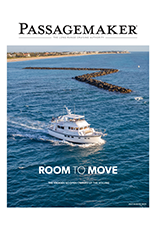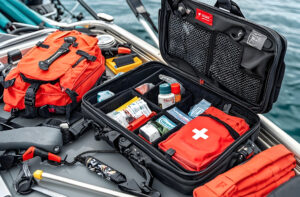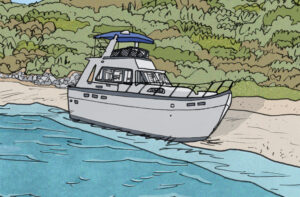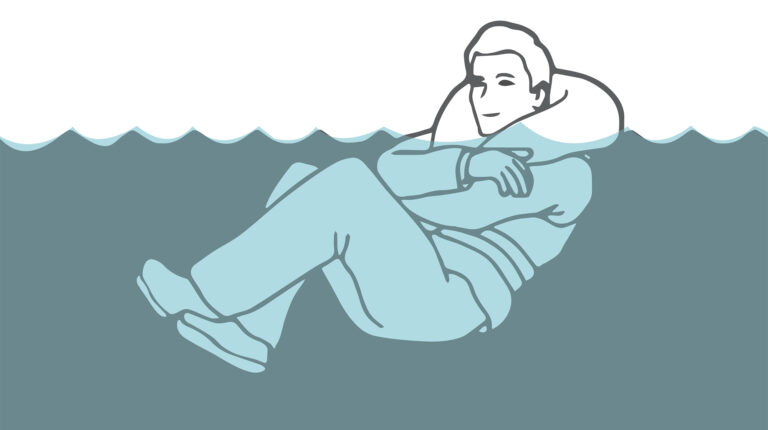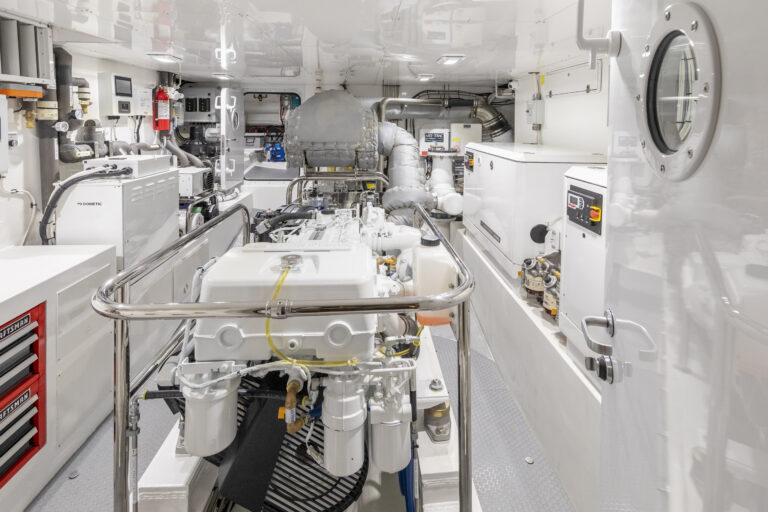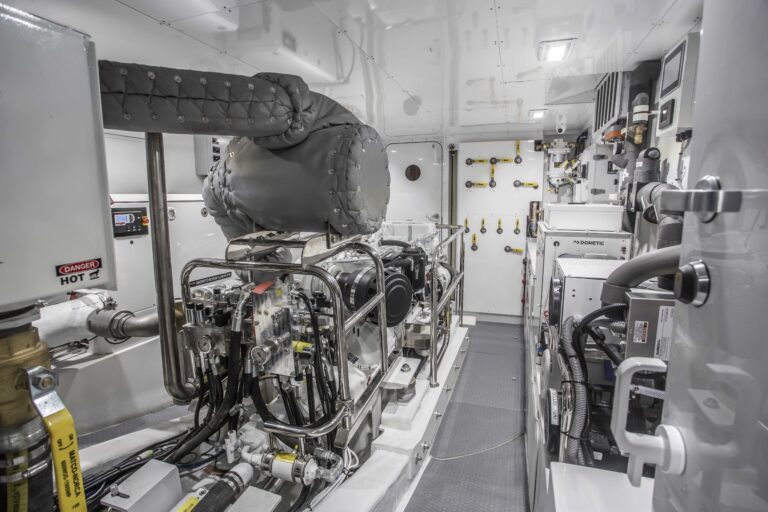Have you ever wished you could spend a little time cruising in new territory with new sights, new challenges, and new fun? What’s stopping you? If the daunting prospect of ocean runs is holding you back, there is another option. Yacht shipping services are available that can transport your boat to new locations, saving you the worry, the time, and the wear and tear that long ocean runs mean for you and your boat. Whether you have a 30-foot sportsfisherman or a 100-foot luxury yacht, you can easily ship your boat to new cruising or fishing territory. When you compare the costs you would incur to move your own boat with the cost of shipping it, you might find that shipping your boat is well worth the expense.
When my friends Dave and Amy Fulton decided they would take their Anacortes-based Nordhavn 76, Cadenza, to La Paz, Mexico, with the FUBAR rally last December, they soon began to weigh the options for returning their boat by yacht transport ship. They had their hearts set on winter cruising in the sunny Sea of Cortez, but they wanted to spend their summer cruising in British Columbia. And having moved their boat north from San Diego the previous year in March, they knew how tough the trip north along the Pacific coast at that time of year could be-on both boat and crew.
With the help of their captain, Bo Larson (who also happens to be my brother), they contacted two shipping companies that transport yachts by ship. The first company, YachtPath, uses a lift-on/lift-off method that employs heavy cranes to lift the yachts onto waiting cradles on the deck of the transport ship. Since Cadenza weighs in at over 125 metric tons, she was too large for the YachtPath cranes, which are rated up to 100 metric tons.
Next, they contacted Dockwise Yacht Transport, which employs a float-on/float-off method that can accommodate quite large yachts. Dockwise has four semi-submersible transport ships that transport yachts exclusively (no other cargo) and they have destinations in the Mediterranean, northwestern Europe, the East Coast of the United States, West Coast North America, the Caribbean, and the South Pacific. According to Dockwise, pricing depends upon the season and upon the amount of deck space in square footage a yacht takes up on board the yacht carrier dock bay.
Bo filled out Cadenza’s length and beam for the online “quick quote” form to determine cost and availability. Shortly, he received a reply by email. Yes, the Dockwise yacht transport ship, Explorer, would be traveling north up the Pacific coast at the right time. And yes, there was room for Cadenza to ride along from La Paz to Nanaimo, B.C. It wasn’t going to be cheap. Their number was north of $30,000. But as I mentioned, Cadenza had just made the trip up the coast in March and Dave and Amy knew what a difficult trip it could be. It didn’t take them very long to decide to catch a ride on a big ship instead.
In May, I got to participate in unloading Cadenza from the Dockwise transport ship in Nanaimo. When I first arrived on board the transport ship and looked inside, what I saw was a colorful jumble of vertical masts and horizontal and diagonal lines, all held together by tall, gray steel walls on either side and the rusted steel floor below. I was reminded of the child’s game “pick-up sticks.” On closer look though, I saw that white hulls of various shapes and sizes were carefully aligned fore and aft, creating a virtual canvas for this visual cacophony of light and line. There actually was a reassuring order to the colorful slashes of line.
To attain this unintentionally artful visual effect, the Dockwise draftsmen had prepared a comprehensive plan in advance using detailed measurements and weights for each yacht. Explorer had begun its trip in Port Everglades, Florida, in March, loading nine yachts there. In Cristobal, Panama, one more yacht was picked up. Then in La Paz, four yachts were unloaded and 11 were loaded. One yacht was discharged and one was loaded via floating crane in Long Beach, California. And finally, in Nanaimo, all 17 yachts traveling north were discharged. The loading master had known at every stop precisely how he would accommodate each yacht to be loaded and unloaded.
The Loading Process In La Paz
Dockwise had kept in close email contact with the owners to update them on Explorer’s schedule. Due to unpredictable delays in the Panama Canal, Explorer was held up there and consequently loading in La Paz was delayed by three weeks. Luckily, this was not a big problem for Dave and Amy.
Prior to loading, Dockwise asks that each yacht be as light as possible. Bo had prepared Cadenza by emptying the freshwater tanks and the gray and blackwater tanks. In anticipation of the trip, he had refrained from fueling recently, so the fuel tank was relatively low. He ran the bilge pumps and, just before loading, switched the pumps off. In addition, since there would be no power available to the yachts during the voyage, he had the refrigerator and freezers emptied. (Dockwise does provide an option to have riders aboard if the yacht is larger than 80 feet. In that case, power and water would be provided to the yacht, as well as meals on the ship. This could allow maintenance to be performed while the transit is under way. However, since the yacht is inside the walls of the ship, you couldn’t see out much and it might be somewhat uncomfortable.)
With Explorer’s exhaust vents located forward of the yachts, some exhaust from the ship’s engines inevitably lands on the yachts. Dockwise had assured all the yacht owners that they would wash the yachts frequently during the transit, but they also recommended that yacht owners wrap their railings with foil for protection from all the elements during the voyage. Anything that would reduce final cleanup seemed a good idea to Bo, so he and some helpers had waxed the railings and all fiberglass surfaces, and carefully duct-taped plastic tarp material over the inflatable tenders and all the winches.
For loading and unloading, Dockwise requests that each yacht contain a minimum crew of two persons; to provide at least 50 feet of line, both fore and aft, on each side of the yacht; and a minimum of two fenders on each side of the yacht, fore and aft.
On the first morning after Explorer arrived in La Paz, it began its ballasting operation to submerge the ship for loading and unloading. Dockwise had informed each of the 11 owners waiting to load in La Paz what time to be ready. At the appointed hour the 11 yachts clustered around the anchored Explorer and monitored the VHF for further loading instructions. Bo and his crew watched from Cadenza as the four unloading yachts drove out the stern of Explorer. Then, at the loading master’s instruction, one by one, the owners (or captains) drove their own yachts into the opened rear of the ship, above the submerged deck. The loading master directed each yacht to a location above pre-arranged cribbing blocks. Cadenza was the last yacht to load and was positioned amidships between two other yachts. Bo and his crew secured Cadenza to the starboard-side yacht as instructed, then shut down and locked up the boat, and climbed off onto the neighboring yacht and then over to the gangway inside the transport ship. Bo, along with all the other captains or owners, then delivered a key to the onboard office and completed some additional paperwork. Finally, a Dockwise skiff returned the yacht crews to shore.
Back on board Explorer, the Dockwise divers installed temporary supports to hold the yachts stationary prior to raising the ship’s deck. With the yachts secure, Explorer’s big stern gate was closed, and the Dockwise crew began the process for pumping water out of the ballast tanks, effectively raising Explorer so that its deck was no longer submerged. Once Explorer’s deck was dry, sea-fastenings were welded into place on the deck under each yacht and then tensioned to the yachts. Heavy polyester straps were tensioned from the side walls of Explorer to each yacht to further secure them. With all yachts secure, Explorer was ready to close its stern gate and begin its voyage.
Explorer’s original itinerary had not called for a stop in Long Beach; however, due to a minor mechanical issue, it was required to make a two-week stop there. The unloading date in Nanaimo was correspondingly pushed back. The Dockwise team sent regular updates to all the yacht owners during Explorer’s northward progress.
The Unloading Process In Nanaimo
Bo, my partner Bruce, and I arrived in Nanaimo the day before the unloading to be sure we’d be there and ready for action at the appointed hour of 0830. Since Cadenza was the last yacht loaded, she would be the first offloaded. She was in the center position of three yachts at the aft of the ship-directly in front of the big stern gate, which would eventually open to let all the boats out.
At 0820, the three of us eagerly climbed up the gangway of the transport ship along with all the other crew and owners. I knew that Bo was anxious to get on board Cadenza. He wanted to be sure he’d have plenty of time to prepare for unloading without being rushed, and it was clear the other yachtsmen had the same thoughts. At the top of the gangway, we were met by a polite, young, orange-jumpsuited man with what I found out was a Ukrainian accent. He requested our passports in broken English and, consulting his list, had us sign our names. Then he waved us onto the upper perimeter deck of Explorer. Now we had our first full view of the yachts inside as I described.
The owners (or captains) of each vessel were required to appear in the onboard office to complete some paperwork before boarding their yachts. Since there was only one ship’s agent available, this task turned out to be a lengthy process. A long line of anxious yachtsmen formed in the dimly lit steel hallway outside the shipboard office. But despite everyone’s tense anticipation, an air of camaraderie and adventure prevailed in the hallway. Each captain, after completing the formalities, hurriedly left the office, hoping to have plenty of time to prepare his or her yacht before starting its engines after several weeks of drydocking. Finally, Bo emerged from the office and we could head to Cadenza.
Many of the yachts were accessible by the gangplanks on Explorer’s interior side walls, but since Cadenza was located in a center position, we needed to access her from the main deck of the ship. We made our way down three steep flights of stairs on the aft side of Explorer’s superstructure. Then, weaving our way through the shadowy forest of dark hulls, stepping over cables, and around ladders, we found our way aft to the Nordhavn. With a draft of almost 8 feet, she loomed far over our heads. One of the Explorer crew members tipped up an extension ladder that stretched just enough to reach the swim step, and we carefully clambered up it.
We were delighted to see that Cadenza looked to be in great condition, and the Explorer crew had done a good job of cleaning. We hurried to begin the tasks necessary for getting the yacht under way, but there was little we could really do. With no water under the hull to be sucked through the cooling lines, we were unable to start even the generator. We checked as much as we could and then busied ourselves removing the protective tarps and plastic coverings from the tenders, the winches, etc. Then we waited.
Standing on the deck, we had plenty of opportunity to chat with the crews on nearby yachts. On our port side was a 40-foot catamaran built by the owner. He and his wife had sailed south during the previous year. On our starboard side was a McQueen 92, with a professional crew aboard. Nearby was another Nordhavn. Sprinkled throughout the inside were several other trawlers, fishboats, catamarans, and sloops. The largest yacht aboard was a 150-foot Feadship.
Everyone was eager to get under way, but there was still no water beneath our hulls. Crews on all the yachts scanned the walls of the big ship containing us, hoping for some movement or sign of impending action. The sun occasionally poked out from the clouds and warmed us a little, but generally it was rather cold and we were just waiting. Everyone seemed to pass the time by speaking to their neighboring yachts about their boats and about where they had been and where they were going next.
At around 1100, I was piqued to awareness from my sitting up, half-doze in the pilothouse when, through the general drone of conversations outside, the word “water” was spoken with a slightly different tone, which poked my consciousness. I moved outside and looked down. Sure enough, there was an inch of water on the ship’s deck beneath us. Wonderful! Soon we’ll be free, I thought.
And we waited some more.
As the water slowly filled in, the catamarans and smaller yachts mostly secured in the center of the ship began floating up first. As each boat gained buoyancy, the Explorer crew began the task of releasing the heavy polyester straps connecting them to the inside of the big ship. These sturdy straps had been secured in varying ways using whatever cleats, winches, masts, or other solid moorings were available on the yachts. Each yacht’s own lines remained secured to Explorer or to a neighboring yacht, but with the immobilizing effect of Explorer’s straps removed, the boats began naturally to drift a little. We noticed the catamaran to our port begin to drift in our direction and we called out to have them adjust their lines while we added more fenders on that side.
I distinctly felt the same nervous anticipation-or perhaps I should call it performance anxiety-that I have sometimes felt when traveling through the Hiram M. Chittenden Locks in Seattle. There, the crew needs to be ready to leap into action at the lock master’s call, and to handle lines and fenders effectively with a minimum of fumbling. That’s not so hard really, but because of the current running through the locks, failing to properly secure your lines quickly could be hazardous to your boat and those around you, or at the very least cause excruciating embarrassment. Here on Explorer, there is no current as the water gently fills around us, but a slight nervous anticipation prevails nonetheless.
By around 1300, we were finally afloat-the Nordhavn being one of the very last to gain buoyancy because of her deep keel. It had taken a good two hours to fill the ship with water, and we were ready to get going. But next we began to hear banging sounds, and someone told us this was the pair of divers working beneath us to remove the drydock cradles from below each yacht to create a clear underwater path. Since there were 17 yachts on Explorer and only two divers, the process of removing the cradles and sea-fastenings turned out to be a lengthy procedure. With divers still in the water, engines must remain off. A palpable anticipation was in the air as we all waited anxiously for deliverance from the belly of this steel whale.
At around 1500, we were still waiting to hear the go ahead to start our engines. I had been glancing regularly toward the big stern gate directly behind us, which was still in the closed position. Finally, I saw it begin to move and then fully open. Everything moved quickly then. Right away, the catamaran alongside was given the go ahead to back out, which they did straightaway, with glee. Immediately following, we received a VHF call from the loading master stating we were clear to depart. We started up our engines and took a couple of minutes to check the systems. Then we cast off our lines from the yacht to starboard and slowly backed straight out. Once outside, we spun around and, with relief, headed for our reserved mooring in town.
As one of the first to offload, we avoided whatever drama might have occurred with the unloading of yachts deeper inside of Explorer. I imagine everyone stood by with fenders to protect themselves from any scrapes and I imagine there was probably a little bit of shouting involved, just like there is in the locks. Looking back toward Explorer, we saw that one yacht was being towed dockside by a tug. Apparently her engine did not start and the tug was standing by specifically for that possibility. The rest of the yachts exited in fairly quick succession and there were no apparent mishaps. The waiting was over.
The Final Analysis
Anyone planning to use a yacht shipping service should allow plenty of leeway in their schedules to accommodate unforeseen scheduling changes. But that’s just common sense and sea sense. No ocean voyage on any size vessel can be planned and executed like clockwork. The Dockwise crew was professional and courteous throughout, and the Nordhavn arrived without a scratch and within five weeks of the original time frame. For my friends, there is no question that the ease of moving the Nordhavn up the Pacific coast via a piggyback ride was well worth the relatively minor waits.
In the Pacific Northwest, we are blessed with such extensive and beautiful cruising grounds that no one I know would ever claim to have seen it all. Countless yachtsmen have cruised their entire lives here in the inland waters of Washington State and British Columbia, and have been thoroughly fulfilled with the quantity and variety of cruising stops. And yet there is still the dream of exploring completely new territory, with different sights and fresh challenges. If you are one of those who have wished to venture into new cruising grounds, but have been stopped by the prospect of the long ocean runs required, it is certainly understandable. But before you give up such a dream, check into all the options. You just might find a way to have the cruise of a lifetime.
